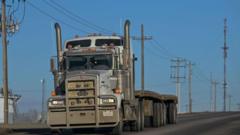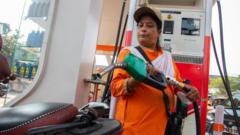In the ever-evolving landscape of logistics, the trucking industry is witnessing a digital revolution that promises increased efficiency but also raises significant concerns regarding job security and wage levels.
Jared, a seasoned truck driver from Canada with over two decades of experience, has adapted to new technologies that allow him to manage his workload more efficiently. He now operates multiple devices simultaneously while driving, utilizing digital trucking platforms that connect drivers to businesses needing freight transportation. "Back in the day, you had to sit by a payphone and start calling," he recalls, contrasting it with the seamless, real-time connectivity of today.
However, Jared also highlights a downside: wages have dropped significantly since the onset of digital platforms. Pre-pandemic, he earned about $3 per mile, but rates have plummeted to approximately $1.10 for certain routes. This trend poses a challenge, particularly as fuel prices soar and living costs increase.
The Canadian trucking market has seen the rise of several prominent platforms, including Uber Freight, which aim to digitalize the fragmented industry. With more than 80% of trucking firms in Canada employing fewer than five people, these apps seek to simplify freight matching in an otherwise disorganized sector. Christopher Monette from Teamsters Canada expresses concerns that gig-style work could stagnate wages even further, emphasizing that truckers need better pay and protections rather than reliance on apps.
Despite these issues, companies like Freightera are challenging the status quo by allowing carriers to set their own prices and offering a more reliable workflow. Co-founder Eric Beckwitt notes the importance of controlling supply and demand while maintaining transparency regarding routes and costs.
Globally, the trucking sector is also adapting to similar technologies. In Kenya, where over 75% of freight is transported by road, digital platforms are revolutionizing logistics management, ensuring trucks operate efficiently and reducing idle time. This not only aids in lowering operational costs but may also contribute to reducing carbon emissions associated with freight transport.
As technology continues to advance, the industry faces pivotal questions about automation. Driverless trucks are currently being tested in countries like the U.S. and China, sparking debates over their potential to replace human drivers. While some believe automation is on the horizon, Jared remains skeptical, arguing that human involvement in transportation is here to stay, at least for the foreseeable future.
In summary, while digital innovation offers promising efficiencies in trucking, the implications for wages and job security remain pressing issues that cannot be overlooked. The challenge lies in balancing technological advancements with the needs and rights of workers in an industry that is rapidly changing.
The trucking industry's adoption of technology is transforming operations, but it brings forth critical concerns about worker welfare and sustainability that require urgent attention as this digital trend grows.
Jared, a seasoned truck driver from Canada with over two decades of experience, has adapted to new technologies that allow him to manage his workload more efficiently. He now operates multiple devices simultaneously while driving, utilizing digital trucking platforms that connect drivers to businesses needing freight transportation. "Back in the day, you had to sit by a payphone and start calling," he recalls, contrasting it with the seamless, real-time connectivity of today.
However, Jared also highlights a downside: wages have dropped significantly since the onset of digital platforms. Pre-pandemic, he earned about $3 per mile, but rates have plummeted to approximately $1.10 for certain routes. This trend poses a challenge, particularly as fuel prices soar and living costs increase.
The Canadian trucking market has seen the rise of several prominent platforms, including Uber Freight, which aim to digitalize the fragmented industry. With more than 80% of trucking firms in Canada employing fewer than five people, these apps seek to simplify freight matching in an otherwise disorganized sector. Christopher Monette from Teamsters Canada expresses concerns that gig-style work could stagnate wages even further, emphasizing that truckers need better pay and protections rather than reliance on apps.
Despite these issues, companies like Freightera are challenging the status quo by allowing carriers to set their own prices and offering a more reliable workflow. Co-founder Eric Beckwitt notes the importance of controlling supply and demand while maintaining transparency regarding routes and costs.
Globally, the trucking sector is also adapting to similar technologies. In Kenya, where over 75% of freight is transported by road, digital platforms are revolutionizing logistics management, ensuring trucks operate efficiently and reducing idle time. This not only aids in lowering operational costs but may also contribute to reducing carbon emissions associated with freight transport.
As technology continues to advance, the industry faces pivotal questions about automation. Driverless trucks are currently being tested in countries like the U.S. and China, sparking debates over their potential to replace human drivers. While some believe automation is on the horizon, Jared remains skeptical, arguing that human involvement in transportation is here to stay, at least for the foreseeable future.
In summary, while digital innovation offers promising efficiencies in trucking, the implications for wages and job security remain pressing issues that cannot be overlooked. The challenge lies in balancing technological advancements with the needs and rights of workers in an industry that is rapidly changing.
The trucking industry's adoption of technology is transforming operations, but it brings forth critical concerns about worker welfare and sustainability that require urgent attention as this digital trend grows.





















